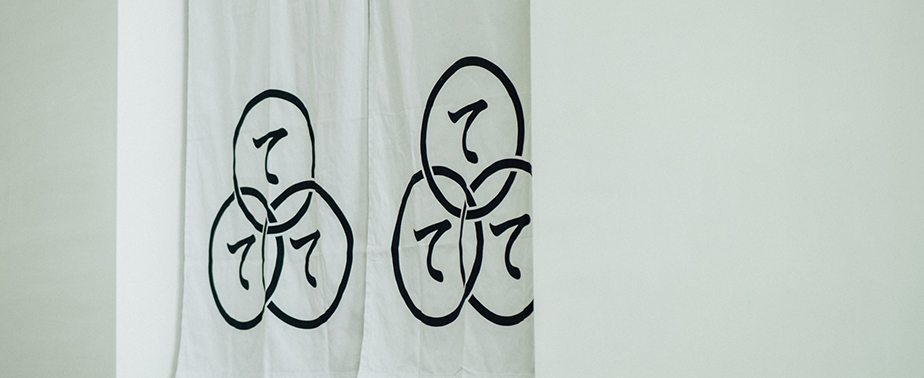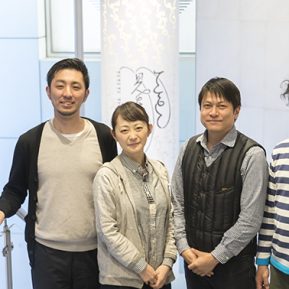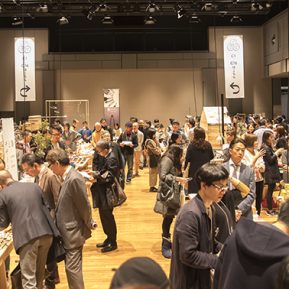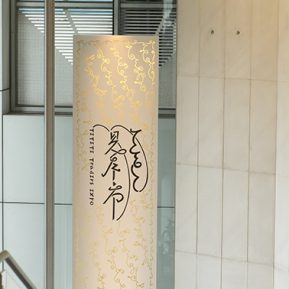
TE TE TE Consortium
Founded in 2012 by a designer, design director, international distributor, and planning director—four people involved in creating products in different ways. These four people operate the TE TE TE Traders Expo to support small and medium scale creators based on the “handicrafts produced on a medium scale” theme. From left, Masanori Oji, Yukiko Yoshikawa, Takuya Matsuo, and Okisato Nagata.
Medium-scale production and handicrafts
–First, please tell us how you came to start the TE TE TE Traders Expo in 2012.
Oji We were originally each working with creators in our own fields, but when we thought about the next step for the creators we were working with, there wasn’t really a trade fair that was a perfect fit for them. So we initially started with a casual idea, saying, “Okay, let’s make one ourselves, then.”
Nagata At the time, there were very few trade fairs held once a year. To exhibit at one of the large-scale trade fairs held two to four times a year, you need to pay a high exhibition fee and prepare new works for each show. That makes it a high hurdle for creators working on a small scale in regional areas.
Oji Rather than a place for business meetings focused on scale or profits, we wanted to make it a place that defines the way creation can be. To us, that meant creating a trade fair that organically links the creator, conveyor, and user.
Nagata It makes it really tough to find a way to escape from the cycle of large-scale consumption if you’re forced to present consumable items on a cycle with short turnaround times. The products are ultimately sold in stores, but it didn’t seem right to create products to fit stores’ needs to keep their lineups fresh.

Last year’s show. Many buyers attended and made contacts with exhibitors.
–For the sixth show, there are now over 100 exhibitors.
Nagata We started with 20 exhibitors, and now we’re at three digits. The four of us started this as a side activity, and it has come this far. At the time, I was 32, and I think Oji-san was 35. Looking back now at the things we picked and the standards we used, I think our tastes skewed a lot older than our actual ages.
Oji Now that we’re older, things are finally starting to match up.
Nagata Efforts to explore the next stage in creating things have been taking place in various places around the world in recent years, such as an effort called “New Crafty” in the Netherlands and a magazine feature called “modern craft.” People all over the world are working hard to find something that hasn’t been defined in words yet, and I remember being excited to be in that crucible as well when we first started.

“tone,” a brand by the Takaoka copperware maker momentum factory Orii, Co., Ltd. was shown at the 2016 TE TE TE Traders Expo. It is slated to appear at the 2017 show as well.
–Various companies have used their exhibits at the TE TE TE Traders Expo to launch their brands. In particular, we’re seeing a large shift with workshops and craftspeople that have focused only on production now thinking about product planning and distribution.
Oji Initially, we were worried that people might not understand the medium-scale production handicrafts concept.
Nagata By talking about handmade products that could be produced even a little at a time, we wanted to pose the question, “What is the ideal quantity for making things?” Now that we’ve talked about it for six years the idea has spread a little, but it hasn’t led to a new trend yet. We need to work harder.
Oji I think it would be interesting if “medium-scale production handicrafts” could become a category of its own, like “creators” or “crafts” or “traditional craftwork.” I’d like to differentiate it clearly from the other categories.
Nagata I’m always thinking about where I’m standing now, and which direction I’m facing. Terms like “crafts” and “regional” are so vague and broad that unless I keep thinking about it, I feel like I’ll lose track of where I am.
–There are a lot of convenient words and phrases we can use when talking about handicrafts, such as “meticulous” and “everyday life.” You run the risk of words losing their meaning unless you define them clearly when you use them.
Nagata Right. That’s why I want to always confirm where I am on the map.

Nagata talks about the relationship between crafts and regional areas in the TO SEE store, where crafts and design goods gather from all over Japan.
–Have you seen a change in the visitors to the expo in the past six years?
Oji We’ve seen a big increase in buyers from overseas. In addition, we have a wide variety of visitors every year, including media, people from local governments, and designers and producers involved in product creation in regional areas.
Nagata On the other hand, we’re seeing fewer buyers from large-scale retail such as department stores. When we put on the first expo you couldn’t find many traditional craft retail spaces outside of department stores. But now you find them in a variety of retail formats, so we have a wide range of buyers as well. We’ve even had buyers from beauty salons come to the show.
Oji The rise of online shops has been impressive, too. A few years ago there were many producers who wouldn’t do business with anyone who didn’t have a physical store, but online shopping is the mainstream now. We’re revisiting the best way to convey and sell products online, where customers can’t pick up the product and feel it for themselves.
–What trends do you see with the exhibitors?
Oji Our objectives are different from what they were initially. With each successive show, we’re seeing creators we work with hold off on exhibiting. That means they’ve made good connections through TE TE TE Traders Expo and have moved on to the next stage. It’s a wonderful trend. New creators come in to take their place, so it helps renew and refresh the show, too.
Nagata Many creators have widened their distribution internationally through their exhibits at TE TE TE as well. Moving on and making room for new creators is really ideal. I think this is the goal we want to strive toward with TE TE TE in the future, too. We’ve kept the exhibition fees low compared to other trade shows to make it easy for young creators to participate, after all.

The graphic for 2017 was created by Katsunobu Yoshida, a graphic designer living in Yamagata Prefecture.
–How do you see the 2017 TE TE TE Traders Expo?
Oji One of the big changes is that we’re in a new venue this year. The unique characteristics of the Aoyama area will probably give our exhibitors and visitors a slightly different feel. We got about twice as many applicants as slots this time, so the selection process was time-consuming.
Nagata We make our selections without seeing the actual products, so we spent a lot of time getting a feel for the creators themselves. This time, we spent up to thirty minutes talking about a single applicant—”What kinds of activities is he involved in?” and “I wonder what kind of meaning that has,” etc. If we couldn’t get a clear idea, we’d pick up the phone and call them on the spot. Many of the exhibitors are people we invited to the show because we wanted to meet them in person.
Oji It makes me really happy when we get an application from someone who seems like a great fit for TE TE TE, or someone I had been hoping would participate. It makes me feel like our message is getting out there.
Nagata We have a large number of exhibits compared to the venue’s capacity, so I think it’s going to feel even more like a temple festival than in previous years. Not just the main thoroughfare leading to the temple, but the area behind it will be packed with stalls, too. A temple festival is part street fair and part ceremony, and that’s what TE TE TE is striving for. The day of the festival, the spotlight will be on the creators. We’re going to be the equivalent of the old folks from the local community hanging out in the staff tent at a festival—they sit in the tent and drink the entire time, but if something happens they’ll go take care of the issue.

In the TO SEE store, we find lacquerware artist Osamu Sakamoto’s brand “urushi no irodori” that is shown at the TE TE TE Traders Expo as well.
–Are there any plans to increase the number of exhibitors in the future?
Oji I think 100 exhibitors are as far as we can grow and still be able to see everyone’s faces. Everyone getting to know each other is one of the great things about TE TE TE, so I’d like to keep things at about this size.
Nagata The venue’s capacity isn’t all that big, and neither is our capacity.
–If you have too many exhibitors you can’t have an afterparty, after all.
Oji That’s a serious problem.
Nagata Every year, we start by looking for a place for the afterparty rather than the venue for the show. You can’t have more than 150 people at an afterparty. That’s probably the optimal number and the maximum limit at the same time.

Nagata talks about the future of TE TE TE Traders Expo.
–What’s next for the TE TE TE Consortium?
Oji I’d like to take on a project other than the traders expo with this team someday.
Nagata Our team can handle planning, art direction, PR, project management, and distribution inside and outside Japan, but for some reason nobody has offered us work. I suppose we could come up with our own plan and make it happen, but this is the team that took three years to make business cards and five years to incorporate, so…
Oji It would be great to have a place for TE TE TE, too. I don’t know if it would be a store, or what else it could be.
Nagata Maybe we could add more people to the operations team. Operating TE TE TE doesn’t bring in money, but it helps us make a lot of connections. There are a lot of people whose work could really benefit from getting to know more people.
Oji I can think of some people off the top of my head, like an exhibitor or a designer who is working with manufacturers to create things. It would be ideal to get a few new people to join in, and then bring in new people through word of mouth to keep TE TE TE going. Just like a local festival.
Nagata Right, keeping it going and having fun like a festival is what’s important!
Okisato Nagata
Planning director Born in 1978 and raised in Fukuoka Prefecture. After graduating from Kanazawa College of Art in Aesthetics and Art History, he worked at the 21st Century Museum of Contemporary Art, Kanazawa and a design studio before founding EXS Inc. He works to invigorate regional communities and is engaged in design direction and coordination for product development.
http://exs-inc.com
Masanori Oji
Handicraft designer Born in Hiroshima in 1974. After graduating from university, he worked at an architectural design firm and graphic studio before establishing a design studio. He is engaged in product design, branding, graphic design, and more for various Japanese handicrafts. Representative of Oji & Design.
http://www.o-ji.jp
[Photography location]
TO SEE
244 Tamauecho, Takeyamachi agaru, Koromonotana-dori, Nakagyo-ku, Kyoto
http://t-o-s-e-e.jp
SPECIAL
TEXT BY YUJI YONEHARA
PHOTOGRAPHS BY MITSUYUKI NAKAJIMA
17.02.07 TUE 09:35




